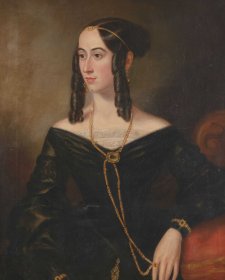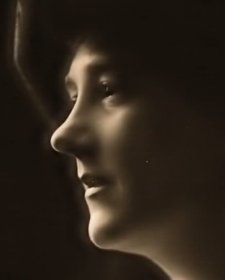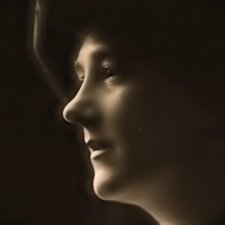Hilda Spong (1875–1955), actress, came with her family to Australia from England in her early teens. Walter Spong, her father, was a scene painter who had worked at the Theatre Royal in Bristol and at Drury Lane. Hired by the Brough and Boucicault Comedy Company, in 1888 he moved to Melbourne, where he became friends with Arthur Streeton and Tom Roberts (who soon painted Hilda's mother). Hilda first appeared on stage when she was fourteen. After taking acting lessons, she made her speaking debut in 1891 in the Brough and Boucicault production of Dr Bill. Two years later, Walter Spong established a company to showcase his daughter's talents. On the basis of triumphs in Melbourne and New Zealand, in 1896 she left Australia to establish her career in London, making her Drury Lane debut in The Duchess of Coolgardie: A Romance of the Australian Gold Fields. Before long she moved to New York City, where she was to star in 50 Broadway productions between 1898 and 1940.
Tom Roberts exhibited his portrait of Hilda Spong at the Art Society of New South Wales in 1893, where it was considered to be one of the best works in the show. At the time, Roberts painted many portraits of prominent actors, musicians and artists.
Purchased with funds provided by the Ian Potter Foundation 2008
The portrait titled Practising the Minuet (Miss Hilda Spong) is an oil on canvas and stands 203cm high and 117cm wide. This large work of the young performer is housed in a heavy, old, gold frame and modestly embellished with a lapping leaf design on its outer rim. The frame is substantial but not overly elaborate. The oil paint evenly coats the surface of the canvas and has a low satin sheen. The artist has employed a realistic style with some of the brush marks visible creating subtle texture and movement.
Artfully arranged, a glowing Hilda stands centrally, poised as if about to dance.
A background of deep, natural green frames the figure, and covers three quarters of the canvas from top to bottom.
On the top right-hand side of the work, the slim edge of a framed picture is visible however the details are indistinct. Adjacent to Hilda’s left shoulder is a collection of long upward strokes in brown and black with touches of gold indicating some sort of plant reminiscent of rushes, the base of which is obscured by Hilda. The green backdrop seems to be made of fabric, indicated by the suggestion of folds and creases in the lower left-hand corner.
Beneath her feet the hard, polished floor captures some reflected light in varying tones of chocolate, chocolate gold and red brown.
Hilda is a young woman with fair skin, auburn hair clipped up in a loose style and dark eyes that gaze upwards to her right. She has a rosy complexion, pink lips and a gentle smile.
She stands composed, her right foot pointed forward, and left hand gracefully holding out the sweep of her dress. In her right hand, raised up level with her eyes, she holds a large splayed white fan, extending above her head and trailing parallel to her angled body. The fan enhances Hilda’s theatrical pose.
Hilda is wearing a flowing golden, empire-line dress, extending to the tips of her toes. The v shaped neckline is trimmed with lace of the same golden hue as the dress. A section of fabric wraps around her chest, it ties in large bow peeping from behind her back and trails the length of her skirt. The sleeves, puffed at the shoulder, fit tightly along her arm and extend to below the elbow. She is wearing long, fingerless evening gloves, typical of the time.
Barely visible in the bottom left hand corner is the artist’s signature, scratched into the surface of the paint.
Audio description written by Sally Adair and voiced by Emma Bedford
The Ian Potter Foundation (13 portraits supported)



On one level The Companion talks about the most famous and frontline Australians, but on another it tells us about ourselves.



Emma Kindred examines fashion as a representation of self and social ritual in 19th-century portraiture.



Broadway star Miss Hilda Spong was painted by Tom Roberts in 1893.